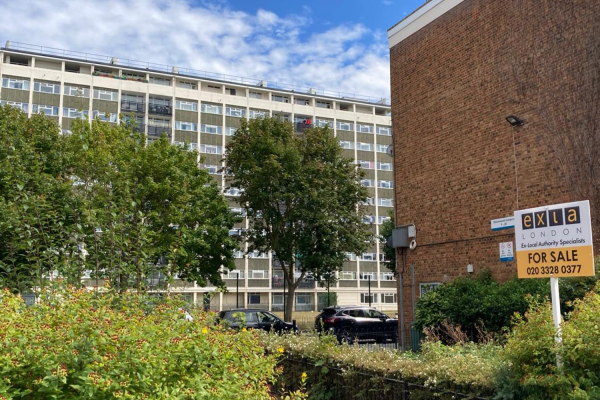An interest-only buy-to-let mortgage is a loan on which the borrower pays only the interest due on the money they have borrowed. The loan is used to pay for a residential property which the borrower plans to let to tenants. Like all mortgages, the loan is securitised against the property, meaning the lender can legally possess the property if the borrower fails to uphold the terms of the mortgage.
What Is an Interest-Only Buy-to-Let Mortgage?
Most buy-to-let mortgages are interest only. That means that every month the borrower only pays the interest on the money they have borrowed. They do not accumulate equity throughout the term of the mortgage and the amount they owe doesn’t decrease from month to month.
Interest-only mortgages will have a term (e.g. 25 years) and you will need to pay off the full value of the mortgage at the end of the term. You will need to demonstrate to the lender how you will plan to do this, although usually it will be through the sale of the property at some point before the end of the term.
The benefits of interest-only loans
The main benefit of only paying the interest is that the monthly payments made are much lower. As a landlord, your profits equal your rental income minus your costs. If you borrow for a buy-to-let property, then your monthly mortgage payments are your biggest costs. By reducing your monthly payments with an interest-only agreement, investing in buy-to-let properties will allow you to make more profit each month.
Having this increased cash flow, allows you to quickly save up money that can be deployed as you see fit. For portfolio landlords, this may mean quickly building up a large enough deposit to buy another buy-to-let property to increase your rental income base even further. For landlords investing for their pension, this may mean higher pension contributions.
The downsides of interest-only loans
You’ll pay more in total
Over the long run you will pay more. This is because you will be paying interest on the whole value of the mortgage for the whole term, and then have to repay the mortgage at the end of the term. This is going to put a big dint in the life-time value of your property investment.
Let’s take an example to show how much more you pay with interest-only.
A repayment buy-to-let mortgage for £100,000 with a 4% interest rate would, over the whole mortgage, cost £145,385 (excluding fees). The monthly payments would be £606.
An interest-only mortgage on the same property and same interest rate would costs £179,920. That’s £34,535 more. The monthly payments would be just £333, however.
Larger deposits mean less leverage
Another drawback is that compared to a repayment mortgage, interest-only mortgages require a larger deposit. This means that it is harder to leverage your capital with multiple properties using this method. Whereas a repayment buy-to-let mortgage typically requires a 25% deposit, an interest-only plan can require up to 40%.
Let’s consider an example to demonstrate the effect this will have on a portfolio investor looking to leverage their cash to the maximum.
Assume an investor has £200,000 they wish to invest in buy-to-let properties. For simplicity, let’s say all properties they are considering costs £200,000. They could buy one property outright for £200,000 and use all their cash. They would have no mortgage and one source of rental income. But if they use repayment buy-to-let mortgages, they could use the £200,000 to pay four 25% deposits, worth £50,000 each. They would then have four mortgages, but also have four sources of rental income. A landlord hoping to do the same with interest-only mortgages would have to pay a 40% deposit, however, meaning their £200,000 could only afford two deposits worth £80,000, before falling £40,000 short of a third.
Capital growth
Finally, if you care about capital growth (i.e. the total value of all your capital assets increasing over time), then you should look at repayment mortgages. Most often, interest-only borrowers sell their property to repay the mortgage. That means the asset leaves their portfolio. Landlords who repay their mortgage, however, eventually come to own the property. Residential property has performed incredibly well over the last 50 years and economists have shown its ownership trends towards monopoly, meaning that owning it is considered a good bet by many investors.
You can’t rely on selling to pay back the mortgage
Although property prices have increased many multiples in recent years, investors absolutely cannot count on selling the property as a guaranteed way to repay their interest-only buy-to-let mortgage. Not only do property prices go down as well as up, but at any given moment, the market in your property’s area could freeze up, preventing you from finding a buyer. This happened in 2008, stinging small-time landlords and huge lenders alike.
What Are the Interest Rates for Buy-to-Let Mortgages?
Interest-only buy-to-let mortgages are common in the buy-to-let mortgage market. Their rates are similar to repayment buy-to-let mortgages and broadly range from 3% to 6%. Like all mortgages you can get fixed or variable rates. There are usually introductory rates and you can usually remortgage to get a better deal once. Large fees may apply if you continue to switch.
Landlords used to be able to claim tax relief on their mortgage interest payments. This made buy-to-let a very attractive investment. But this tax relief has been phased out, and landlords may no longer claim relief against interest payments.
What Are the Criteria for Buy-to-Let Mortgages?
Portfolio landlords (with four or more properties) will need to demonstrate the viability of individual property investments, rather than pointing to the overall profitability of their wider portfolio, when applying for a new mortgage. Lenders may also have a maximum portfolio size they are willing to lend to. Your portfolio may also need to have a loan-to-value (LTV) ratio that falls below a maximum. All of these things reduce risk for lenders.
For an expert’s insight into buy-to-let mortgages, we asked Will Rhind, Mortgage Expert at broker Habito, for what lenders will need.
“With buy-to-let, it’s predominantly based on the rental income and the deposit. The deposit needs to be 25% of the property price in most cases and an ICR (interest coverage ratio) is applied on the rental, to ensure its sufficient to cover the mortgage payment by a certain percentage at a certain interest rate.
“The Interest Cover Ratio is part of the basic affordability calculation that is typically applied to buy to let mortgage applications. The ICR is the minimum ratio between the expected rental income of the property and a notional interest rate – or “Stress Test”.
“For example, a typical buy to let mortgage product for a limited company applicant might require that the property can yield rent worth at least 125% of the notional interest rate. The ICR in this example is 125%. If the expected yield does not sufficiently exceed the notional interest rate, lenders may choose to examine additional sources of income to assess affordability.
“So assuming the rent is sufficient, the deposit is sufficient and they have a suitable means of paying off the mortgage at the end of the term (for example, by selling the property), interest-only is pretty straightforward for landlord applicants.”




Start the discussion at community.openrent.co.uk